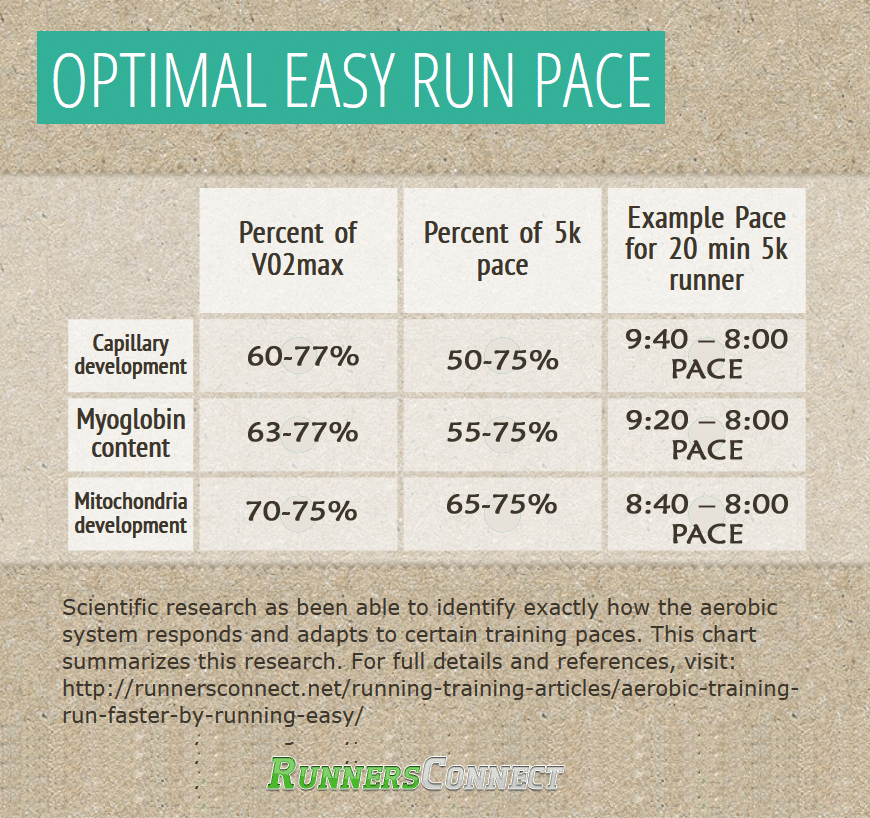What Should Be My Easy Run Pace
A common question, and one of the more difficult concepts of training to comprehend, is "how do easy runs help me race faster".
If you want to run a marathon at 9 minutes-per-mile, how does running 5-8 miles slow, or even your entire long run, at 10:30 pace help you?
Wouldn't running all your miles as close to 9 minute-pace as possible make more sense?
You would think, but no.
Logically, it would make sense that pushing your easy run pace as close to race pace as possible would help you get fitter quicker and ultimately run faster.
After all, the harder you work the better you get, right?
Yet, most good coaches will tell you to run slow on your easy days and your easy running cadence should be the same as your other runs.
We found that running 80% easy will make most runners 23% faster, which you can read more about if you need the research.
Now:
At RunnersConnect, almost all our new team members ask at some point "why are my easy days so slow" or "how am I supposed to run fast if I am running easy all the time"
The answer to these questions lies in what coaches call the aerobic system.
The aerobic system, and thus aerobic development, is the one true secret to training and it's the key to unlocking your potential.
In this article, we're going to examine why the aerobic system is so important, what the aerobic system is, and how to target it in training.

Why Do I Need to Run Easy?
The first step to understanding just how important the aerobic system is to distance running is to identify the percentage of energy contribution the aerobic system provides for races 5k and longer.
As you can see in this chart, even for a "short" event like the mile, over 80% of the energy required to run the race is produced via aerobic metabolism.

Looking at the research and the scientific data, we now know that the aerobic system is extremely important to distance running.
But, what is the aerobic system and how does developing it help you run faster (if you're always running so slow all the time)?
What is the Aerobic System?
First, we need to understand exactly what the aerobic system is and how it relates to easy running.
At the heart of aerobic training is the scientific fact that to exercise, your body needs to break down sugar and convert it to glycogen so it can be used as energy or fuel.
In the presence of adequate oxygen, the body utilizes the aerobic system, also known as aerobic glycolysis, to power continuous running.
In the aerobic system energy ATP is produced through Pyruvic Acid and Lipid/Protein fragments entering the Kreb Cycle and the Electron Transport Cycle.
During aerobic respiration, you breathe in, the body efficiently uses all the oxygen it needs to power the muscles, and you exhale.
When you are "running aerobically" (or running easy), your muscles have enough oxygen to produce all the energy they need to perform.
What's the bottom line?
Improving your capacity to transport and efficiently utilize available oxygen to produce energy will enable you to race faster.
Why?
This makes up 85-99% of the energy needed to race.
As running easy is aerobic development there's no better way to train the aerobic system.
Now that we understand what aerobic running is we can examine the specific physiological adaptions that occur when you develop the aerobic system.
Capillary development
Capillaries are the smallest of the body's blood vessels and they help deliver oxygen and nutrients to the muscle tissues while shuttling waste products out.
The greater the number of capillaries you have surrounding each muscle fiber, the faster you can transport oxygen and carbohydrate into your muscles.
Aerobic training (easy running) increases the number of capillaries per muscle fiber.
How does this help me run faster?
This improves how efficiently you can deliver oxygen and fuel to your working muscles and how quickly they can clear waste products.
Increase myoglobin content of muscle fibers
Myoglobin is a special protein in your muscles that binds the oxygen that enters the muscle fiber.
When oxygen becomes limited during exercise, myoglobin releases the oxygen to the mitochondria to produce more energy.
How does this help me race faster?
The more myoglobin you have in your muscle fibers, the more oxygen you can sequester to the muscle under aerobic duress – like during a race.
Aerobic training increases the myoglobin content of your muscle fibers.
Mitochondria development
Mitochondria are microscopic organelle found in your muscles cells that contribute to the production of ATP (energy).
In the presence of oxygen, mitochondria breakdown carbohydrate, fat, and protein into usable energy.
The more mitochondria you have, and the greater their density, the more energy you can generate during exercise, which will enable you to run faster and longer.
Aerobic training increases both the number and the size of the mitochondria in your muscle fibers.
There are a few other physiological benefits to aerobic training, but that discussion gets a little too scientific and likely only interesting to biology majors.
How does this help me race faster?
Aerobic development is the single most important factor to long-term development.
Sure, track workouts, VO2max sessions, and tempo runs will increase your fitness and are still important to racing faster.
However, nothing will consistently help you improve continuously like developing the aerobic system.
Why Doesn't Running Faster on Easy Days Make Me Get Faster in Races?
Now, the million dollar question:
Won't running faster and pushing harder on your runs develop the aerobic system more rapidly?
Nope.
Not only will running faster result in diminished aerobic development, but it increases the chances of injury and overtraining.
Double whammy.
This is the single biggest mistake runners of all experience levels make in their training.
Since I firmly believe that understanding the "why" of training is critical to executing workouts and training correctly, and I don't expect you to take my word for it.
Let's look at why:
What is the best easy run pace for me?
Scientific research as been able to identify exactly how the aerobic system responds and adapts to certain training paces.
Physiologically, we know:
Capillary development appears to peak at between 60 and 75 percent of 5k pace.
Research has shown that maximum stimulation of myoglobin in Type I muscle fiber occurs at about 63-77 % of VO2max.
What does that mean?
63-77 % of VO2max is about 55-75 % of 5k pace.
A little easier to figure out, right?
Two researchers, Holloszy (1967) and Dudley (1982) published some of the defining research on optimal distance and pace for mitochondrial development.
Holloszy found that maximum mitochondrial development when running at 50-75 % of V02max.
Likewise, Dudley found that the best strategy for slow-twitch, mitochondria enhancement was running for 90 minutes per outing at 70 to 75 % V02 max.
Now:
I know that's a lot of statistics and numbers, so if you're not as analytically inclined as I pretend to be, here is a neat chart to sum up the research:

What's the bottom line?
Your optimal easy run pace for aerobic development is between 55 and 75 % of your 5k pace, with the average pace being about 65 %.
Running faster than 75% of your 5k pace on your long run doesn't provide a lot of additional physiological benefit.
In fact, the research indicates that it would be just as advantageous to run slower as it would be to run faster.
Even though 50-55 % of 5k pace will seem too easy, the research clearly demonstrates that it still provides near optimal physiological aerobic adaptation.
RunnersConnect Bonus
Download your FREE Long Run and Aerobic Pacing Calculator now.
Need help converting your race times to your optimal easy and long run pace? Download our FREE calculator and we'll do the math for you.
Get My Calculator Now
Why can I not run faster on my easy days if I feel good?
Ok, so we can clearly see from research that running faster isn't going to develop your aerobic system more rapidly.
But, what's the harm in running faster on those days you feel good?
Why do coaches always harp on you to slow down?
Here's the deal:
The faster you run on your easy days, the more stress you place on the muscles, tendons, ligaments in bones.
For example, you may be able to head out the door and hammer out an easy day and feel fine with your breathing, but your hips might not be strong enough yet to handle the pace or the consecutive days of faster running and, as a result, your IT band becomes inflamed.
It get's worse:
In addition to aerobic development, easy days can function as active recovery from your hard workouts – but not if you run them too fast.
After a hard workout, your muscles will have micro-tears from the forceful contractions which happen at fast speeds.
These micro-tears cause muscle soreness, and make training the day after a hard workout difficult.
The body heals these small micro-tears through the circulatory system, which delivers the oxygen and nutrients to the muscles that need repair.
Easy running delivers oxygen and nutrients directly to the muscles used during running.
When running easy enough, the stress and micro tears that result from running are virtually non-existent, so the recovery outweighs the slight muscle damage.
Why do we struggle to run easy?
The reason these two realities are so difficult to understand is that they don't occur instantaneously.
You don't run slightly too fast one day and then immediately get hurt.
The stress and fatigue compounds, so it's difficult to attribute it to one run.
But you know what to do to make sure you do find the right pace for your easy run to allow for recovery and prevent you being on the verge of overtraining or injury.
And if you don't, we have the calculator to do it for you.
RunnersConnect Bonus
Download your FREE Long Run and Aerobic Pacing Calculator now.
Need help converting your race times to your optimal easy and long run pace? Download our FREE calculator and we'll do the math for you.
Get My Calculator Now
Source: https://runnersconnect.net/aerobic-training-run-faster-by-running-easy/
0 Response to "What Should Be My Easy Run Pace"
Post a Comment